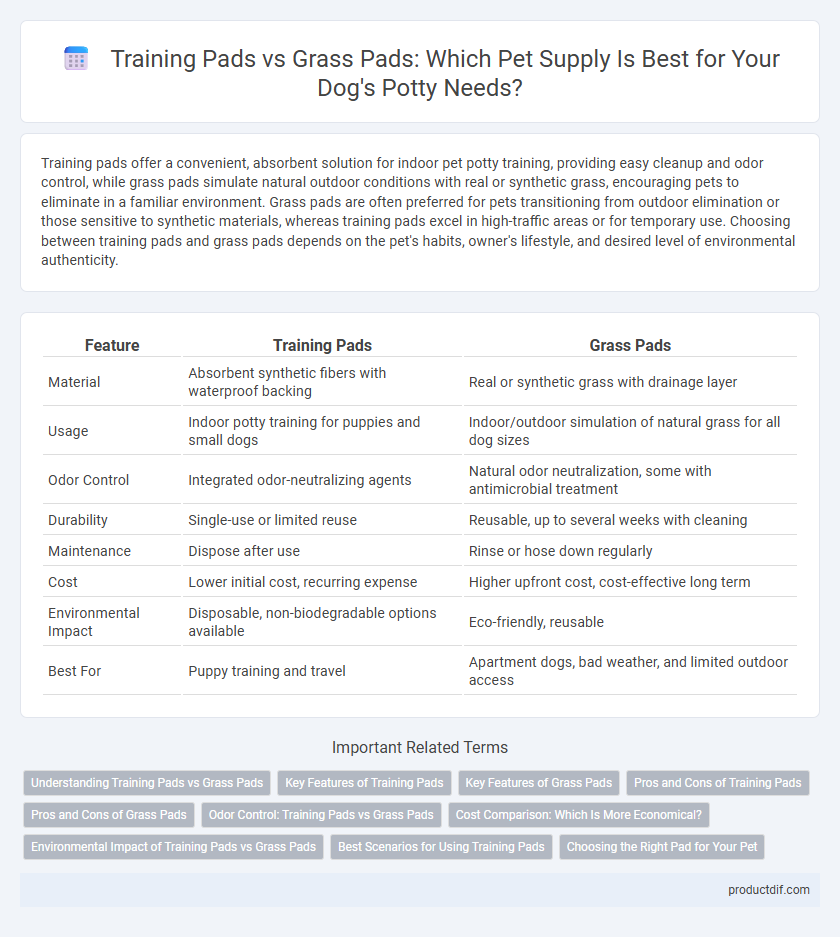Training pads offer a convenient, absorbent solution for indoor pet potty training, providing easy cleanup and odor control, while grass pads simulate natural outdoor conditions with real or synthetic grass, encouraging pets to eliminate in a familiar environment. Grass pads are often preferred for pets transitioning from outdoor elimination or those sensitive to synthetic materials, whereas training pads excel in high-traffic areas or for temporary use. Choosing between training pads and grass pads depends on the pet's habits, owner's lifestyle, and desired level of environmental authenticity.
Table of Comparison
| Feature | Training Pads | Grass Pads |
|---|---|---|
| Material | Absorbent synthetic fibers with waterproof backing | Real or synthetic grass with drainage layer |
| Usage | Indoor potty training for puppies and small dogs | Indoor/outdoor simulation of natural grass for all dog sizes |
| Odor Control | Integrated odor-neutralizing agents | Natural odor neutralization, some with antimicrobial treatment |
| Durability | Single-use or limited reuse | Reusable, up to several weeks with cleaning |
| Maintenance | Dispose after use | Rinse or hose down regularly |
| Cost | Lower initial cost, recurring expense | Higher upfront cost, cost-effective long term |
| Environmental Impact | Disposable, non-biodegradable options available | Eco-friendly, reusable |
| Best For | Puppy training and travel | Apartment dogs, bad weather, and limited outdoor access |
Understanding Training Pads vs Grass Pads
Training pads offer a convenient and absorbent solution for indoor pet accidents, effectively containing urine and minimizing odors with waterproof backing and odor control technology. Grass pads mimic natural outdoor environments by providing real or synthetic grass surfaces that encourage pets to relieve themselves outdoors, supporting house-training routines with a more natural sensory experience. Choosing between training pads and grass pads depends on factors like pet behavior, indoor space availability, and the goal of gradual outdoor transition.
Key Features of Training Pads
Training pads offer superior absorbency compared to grass pads, featuring multi-layer construction that quickly locks in moisture and controls odor for indoor use. These pads often include leak-proof backing to protect floors and are infused with attractant scents to encourage puppies to use them consistently. Their portability and convenience make them ideal for pet owners seeking effective housetraining solutions without reliance on outdoor access.
Key Features of Grass Pads
Grass pads for pet training provide a natural surface that mimics outdoor environments, promoting better potty habits and reducing anxiety for pets. These pads feature real or synthetic grass materials that enhance odor control and absorption while being biodegradable and eco-friendly. Their durability and easy maintenance make grass pads an ideal choice for indoor or balcony use, supporting effective housebreaking.
Pros and Cons of Training Pads
Training pads provide a convenient and absorbent solution for indoor pet toileting, ideal for puppies and small dogs. They offer ease of cleanup and odor control but can lead to pets developing a dependence on synthetic surfaces rather than natural grass. However, training pads may require frequent replacement and can create a learning challenge when transitioning pets to outdoor elimination habits.
Pros and Cons of Grass Pads
Grass pads offer a natural surface that encourages pets to relieve themselves with familiar textures, reducing anxiety during training. They require regular maintenance to prevent odor and bacterial buildup, which can be time-consuming compared to disposable options. While grass pads promote healthier paw hygiene and environmental sustainability, they may not be suitable for all indoor spaces due to limited drainage and potential mess.
Odor Control: Training Pads vs Grass Pads
Training pads often incorporate advanced odor-control technology with absorbent gels and antimicrobial layers that neutralize urine smells effectively. Grass pads provide a natural scent and reduce artificial chemical odors but may retain moisture longer, leading to potential odor buildup if not replaced promptly. Selecting between the two depends on balancing ease of odor management and naturalness preferred for indoor pet hygiene solutions.
Cost Comparison: Which Is More Economical?
Training pads generally offer a lower upfront cost compared to grass pads, making them a budget-friendly option for pet owners. While training pads require regular replacement, grass pads have a higher initial price but tend to last longer with proper care and maintenance. Evaluating long-term expenses, training pads may lead to higher recurring costs, whereas grass pads can provide more economical value over time.
Environmental Impact of Training Pads vs Grass Pads
Training pads often contain plastic components and synthetic materials that contribute to landfill waste and microplastic pollution, raising environmental concerns. Grass pads, made from natural turf, offer a biodegradable and compostable option that reduces synthetic waste and supports sustainable pet care. Choosing grass pads aligns with eco-friendly practices by minimizing carbon footprint and promoting organic decomposition.
Best Scenarios for Using Training Pads
Training pads offer optimal convenience for indoor pet training, especially in apartments or homes with limited outdoor access, providing an absorbent and odor-controlling surface for puppies or small dogs. They are particularly ideal for early-stage housetraining where frequent bathroom breaks are necessary, ensuring a clean, designated spot that reduces accidents on carpets or hardwood floors. Owners of senior dogs or pets recovering from surgery benefit from the ease of disposable training pads, which simplify cleanup and maintain hygiene during extended indoor confinement.
Choosing the Right Pad for Your Pet
Choosing the right pet training pad involves comparing absorbency, odor control, and ease of use, with traditional training pads offering strong absorbency and disposable convenience, while grass pads provide a natural surface that can help pets transition to outdoor elimination. Consider your pet's size, habits, and environment; small breeds may prefer training pads that absorb quickly, whereas dogs accustomed to outdoor bathroom breaks benefit from grass pads mimicking natural turf. Prioritizing durability and sanitation ensures your pad choice promotes a clean, stress-free training experience tailored to your pet's specific needs.
Training Pads vs Grass Pads Infographic

 productdif.com
productdif.com